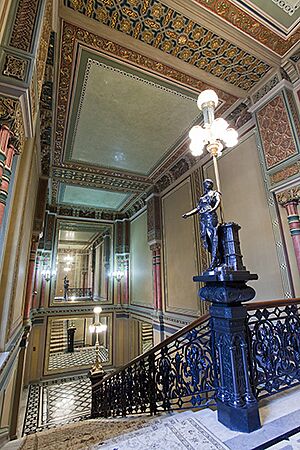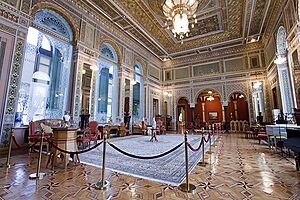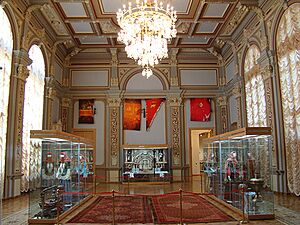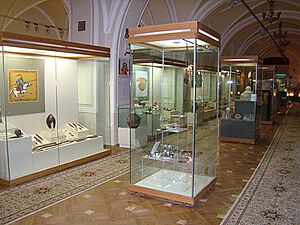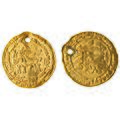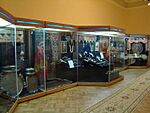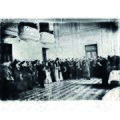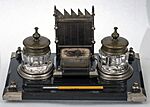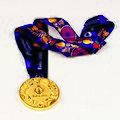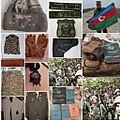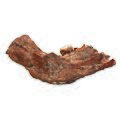National Museum of History of Azerbaijan facts for kids
| National Museum of History of Azerbaijan | |
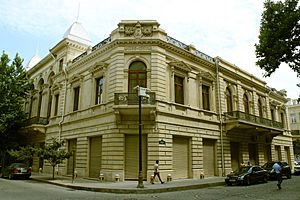
National Museum of History of Azerbaijan
|
|
| Established | 1920 |
|---|---|
| Location | H. Z. Taghiyev Street 4, Baku, |
| Type | National Museum of History of Azerbaijan |
| Public transit access | M 1 Sahil metro station |
The National Museum of History of Azerbaijan (Azerbaijani: Milli Azərbaycan Tarixi Muzeyi) is the biggest museum in Azerbaijan. It is located in Baku, the capital city. The museum is inside what used to be the home of a rich oil businessman and helper of others, Haji Zeynalabdin Taghiyev. The museum started in 1920 and opened its doors to visitors in 1921.
Contents
History of the Museum
The museum building was built between 1895 and 1901. It was first the home for the Taghiyev family. A Polish architect named Józef Gosławski designed it. He made it look like buildings from the Italian Renaissance style. It is a very large building, covering a whole city block. Some parts of it are four floors high.
In April 1920, the Red Army came to Baku. Taghiyev's home was taken over right away. In June 1920, just two months later, the home became the State Historical Museum. This was decided by the government of the USSR.
In May 1934, a special rule was made to make history and geography lessons better in schools. This helped to teach about the history of the country. New history museums were also created to help people learn more.
The museum helped people learn about Azerbaijan's history through its research. From 1925 to the 1960s, scientists studied old items and cultural treasures from Azerbaijan. This was done by archaeologists like Davud Sharifov and Yevgeniy Pakhomov. They dug up old sites in places like Khojaly and Mingechevir. The museum's collections include items found during these digs. They also have items from other trips to study local cultures.
From 1941 to 1954, the Museum of History was moved to the Palace of the Shirvanshahs. The government offices were in the mansion during this time. In 1954, the museum started working again on the second floor of the mansion. By 2000, the entire mansion was given to the Museum of History of Azerbaijan.
The Museum Building
The museum building was once the home of Haji Zeynalabdin Taghiyev and his family. He was a famous businessman and a kind person who helped others. Iosif Goslavsky designed the building. He was the main architect of Baku from 1893 to 1904. He designed twelve other buildings in Baku that are still standing.
About 270 people worked on building the mansion. These included engineers, architects, and painters. They worked from 1895 to 1901. The building itself cost 1.2 million roubles. This did not include the furniture and equipment. All the furniture came from places like Russia, France, America, and Germany. The mansion also had heating and cooling systems.
The mansion has three stories on all four sides. Each room is very tall, reaching 13.20 meters high. The front of the building faces what is now H. Z. Tagiyev Street.
The rooms inside are set up in two rows around two courtyards. The front part of the building has two separate marble staircases. Taghiyev's office was on the first floor. Living rooms, a study, two big ballrooms, a kitchen, and other rooms were on the second floor. The third floor has 16 more rooms.
There are two large ballrooms on the second floor. One is in an Oriental (or Mauritanian) style. The other is in a Western (European) style. The Oriental Hall has huge windows and fancy decorated walls. It also had a winter garden with a small fountain. The European Room has straighter lines.
One of the most beautiful rooms was the private sitting room for Sona Khanum. She was Taghiyev's wife. All the furniture and paintings from this room are gone now. Only the fancy mirrored mosaic ceiling remains.
During the Soviet time, the colorful designs on the walls of the mirrored room were painted over with white paint. This was because they were seen as "old-fashioned." These designs were found again during repairs in 2000. In other parts of the house, the original paint is still there. The paint was made from finely ground eggshell. This was a special way artists used to paint. Even after almost 100 years, the original colors have not faded.
Big repair and restoration work started in the Taghiyev mansion in 2005. A special museum about H.Z. Taghiyev was also created. This was done by President Ilham Aliyev.
Memorial Museum of Haji Zeynalabdin Taghiyev
Experts from Azerbaijan and Italy helped to restore the rooms and items in the Memorial Museum of Haji Zeynalabdin Taghiyev. The rooms look like they did before, based on old family photos. The museum has these restored rooms:
- Taghiyev's Study – This room has Taghiyev's desk, armchair, and books. It also has a painting of Taghiyev by Isaak Brodsky. This painting was made because Taghiyev helped pay for a local technical college.
- Oriental Hall – This is one of the biggest and most decorated rooms. It is designed in an Oriental style. It was used for important meetings and parties. Nine kilograms of gold were used to decorate it.
- Taghiyev's Library – This room shows how much Taghiyev loved learning and helping others. He paid for books by famous writers and poets. He also owned a newspaper and was the first to print the Quran in Azerbaijani.
- Billiard Room
- Dining Room – This room shows fancy chairs, a silver dinner set, and other luxury items.
- Monitored Room – This room has interactive displays for visitors.
- Boudoir – This was a small sitting room for Sona Khanim, Taghiyev's second wife. It is also called the "Mirror Hall" because of its mirrored ceiling and colorful wall designs.
- Bedroom
- Dressing Room
Museum Collections
The National Museum has special collections, called "funds," to help with its work. These funds help with finding old items, keeping them safe, studying culture, and teaching people. As of 2025, the museum has 12 different funds.
The oldest funds started in the 1920s. The Archaeological Fund (1920) helps study Azerbaijan's history and culture. The Numismatics Fund (1920) keeps and studies about 100,000 old coins and other items like stamps and medals. The Ethnographic Fund (1925) shows cultural items and crafts from different groups in Azerbaijan. These include copper items, pottery, wood products, and carpets.
Newer funds include the Special Fund (for precious metals and jewelry) (1955). There is also the Fund of Documentary Sources (1996) and the Fund of Gifts and Memorabilia (2009). The Patriotic War Fund (2021) collects items related to recent conflicts.
Restoration Work
Since it started, the museum has worked to fix and protect its items. At first, they mostly worked on things found during archaeological digs. Now, they have experts who work with many different materials. These include metal, ceramics, wood, fabric (like carpets), paintings, and drawings. The people who work in the lab learn new ways to restore items. They use the best methods in their work.
In 2010, the museum had an exhibition called "The Second Life of Museum's Exhibits." This show highlighted the work of the restoration lab.
Museum Leaders
| Period | Director |
|---|---|
| 1920–1921 | Y. Stanevic |
| 1921 | S. Savelyev |
| 1923 | Mammad Malikov |
| 1923 | Sheikh Ismail |
| 1923–1928 | Davud Sharifov |
| 1928–1932 | Sero Manutsyan |
| 1932–1934 | A. Melkumyan |
| 1934–1937 | M. Salamov |
| 1937 | A. Klimov |
| 1938–1939 | B. Ishanov |
| 1939 | Leviatov V.N. (acting) |
| 1939 | D. Mehdiyev |
| 1940–1942 | Zeynal Aliyev (acting) |
| 1942–1947 | V. Leviatov |
| 1947–1952 | Saleh Gaziyev |
| 1952–1953 | Ishag Jafarzadeh |
| 1953 | V.I. Soxatsky (acting) |
| 1953–1954 | Mammad Efendiyev |
| 1954–1961 | Mammad Gaziyev |
| 1961–1998 | Pustakhanim Azizbeyova |
| 1998 | Ali Rajabli |
| 1998–present | Naila Valikhanli |
See also
 In Spanish: Museo Estatal de Historia de Azerbaiyán para niños
In Spanish: Museo Estatal de Historia de Azerbaiyán para niños
- Zeynalabdin Taghiyev


